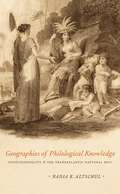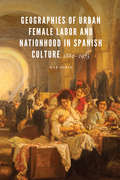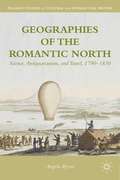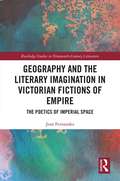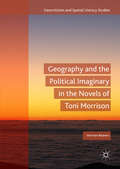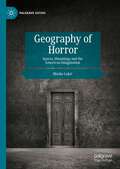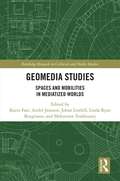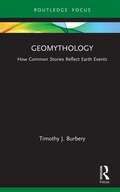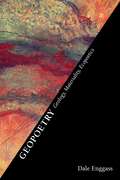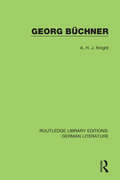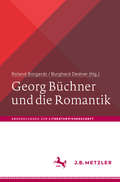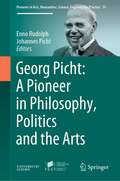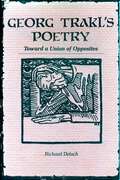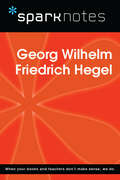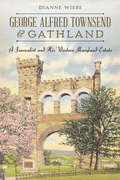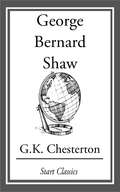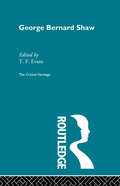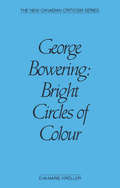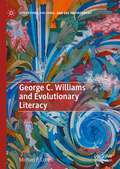- Table View
- List View
Geographies of Philological Knowledge: Postcoloniality and the Transatlantic National Epic
by Nadia R. AltschulGeographies of Philological Knowledge examines the relationship between medievalism and colonialism in the nineteenth-century Hispanic American context through the striking case of the Creole Andrés Bello (1781–1865), a Venezuelan grammarian, editor, legal scholar, and politician, and his lifelong philological work on the medieval heroic narrative that would later become Spain’s national epic, the Poem of the Cid. Nadia R. Altschul combs Bello’s study of the poem and finds throughout it evidence of a “coloniality of knowledge.” Altschul reveals how, during the nineteenth century, the framework for philological scholarship established in and for core European nations—France, England, and especially Germany—was exported to Spain and Hispanic America as the proper way of doing medieval studies. She argues that the global designs of European philological scholarship are conspicuous in the domain of disciplinary historiography, especially when examining the local history of a Creole Hispanic American like Bello, who is neither fully European nor fully alien to European culture. Altschul likewise highlights Hispanic America’s intellectual internalization of coloniality and its understanding of itself as an extension of Europe. A timely example of interdisciplinary history, interconnected history, and transnational study, Geographies of Philological Knowledge breaks with previous nationalist and colonialist histories and thus forges a new path for the future of medieval studies.
Geographies of Urban Female Labor and Nationhood in Spanish Culture, 1880–1975 (New Hispanisms)
by Mar SoriaMar Soria presents an innovative cultural analysis of female workers in Spanish literature and films. Drawing from nation-building theories, the work of feminist geographers, and ideas about the construction of the marginal subject in society, Soria examines how working women were perceived as Other in Spain from 1880 to 1975. By studying the representation of these marginalized individuals in a diverse array of cultural artifacts, Soria contends that urban women workers symbolized the desires and anxieties of a nation caught between traditional values and rapidly shifting socioeconomic forces. Specifically, the representation of urban female work became a mode of reinforcing and contesting dominant discourses of gender, class, space, and nationhood in critical moments after 1880, when social and economic upheavals resulted in fears of impending national instability. Through these cultural artifacts Spaniards wrestled with the unresolved contradictions in the gender and class ideologies used to construct and maintain the national imaginary. Whether for reasons of inattention or disregard of issues surrounding class dynamics, nineteenth- and twentieth-century Spanish literary and cultural critics have assumed that working women played only a minimal role in the development of Spain as a modern nation. As a result, relatively few critics have investigated cultural narratives of female labor during this period. Soria demonstrates that without considering the role working women played in the construction and modernization of Spain, our understanding of Spanish culture and life at that time remains incomplete.
Geographies of the Romantic North
by Angela ByrneThis book examines British scientific and antiquarian travels in the "North," circa 1790-1830. British perceptions, representations and imaginings of the North are considered part of late eighteenth- and early nineteenth-century processes of British self-fashioning as a Northern nation, and key in unifying the expanding North Atlantic empire.
Geography and the Literary Imagination in Victorian Fictions of Empire: The Poetics of Imperial Space (Routledge Studies in Nineteenth Century Literature)
by Jean FernandezIn this pioneering study, Dr. Fernandez explores how the rise of institutional geography in Victorian England impacted imperial fiction’s emergence as a genre characterized by a preoccupation with space and place. This volume argues that the alliance between institutional geography and the British empire which commenced with the founding of the Royal Geographical Society in 1830, shaped the spatial imagination of Victorians, with profound consequences for the novel of empire. Geography and the Literary Imagination in Victorian Fictions of Empire examines Presidential Addresses and reports of the Royal Geographical Society, and demonstrates how geographical studies by explorers, cartographers, ethnologists, medical topographers, administrators, and missionaries published by the RGS, local geographical societies, or the colonial state, acquired relevance for Victorian fiction’s response to the British Empire. Through a series of illuminating readings of literary works by R.L. Stevenson, Olive Schreiner, Flora Annie Steel, Winwood Reade, Joseph Conrad, and Rudyard Kipling, the study demonstrates how nineteenth-century fiction, published between 1870 and 1901, reflected and interrogated geographical discourses of the time. The study makes the case for the significance of physical and human geography for literary studies, and the unique historical and aesthetic insights gained through this approach.
Geography and the Political Imaginary in the Novels of Toni Morrison (Geocriticism and Spatial Literary Studies)
by Herman BeaversThis book examines Toni Morrison’s fiction as a sustained effort to challenge the dominant narratives produced in the white supremacist political imaginary and conceptualize a more inclusive political imaginary in which black bodies are valued. Herman Beavers closely examines politics of scale and contentious politics in order to discern Morrison's larger intent of revealing the deep structure of power relations in black communities that will enable them to fashion counterhegemonic projects. The volume explores how Morrison stages her ruminations on the political imaginary in neighborhoods or small towns; rooms, houses or streets. Beavers argues that these spatial and domestic geographies are sites where the management of traumatic injury is integral to establishing a sense of place, proposing these “tight spaces” as sites where narratives are produced and contested; sites of inscription and erasure, utterance and silence.
Geography of Horror: Spaces, Hauntings and the American Imagination (Palgrave Gothic)
by Marko LukićThis book provides a comprehensive reading of a space/place-based experience from the birth of the American horror genre (nineteenth century American Romanticism) to its rise and evolution in the twentieth and twenty-first centuries. Exploring a series of narratives, this study focuses on the role of space and place as key elements for successful articulation of horror. The analysis, therefore, employs different theoretical premises and concepts belonging to human geography, which, while being part of the larger discipline of geography, predominantly directs its attention towards the presence and activities of humans. By connecting such theoretical readings with the continuously evolving American horror genre, this book offers a unique insight into the academically unexplored trans-disciplinary spatially based reading of the genre.
Geology: Activity Book (Amplify Core Knowledge Language Arts, Grade 4 #Unit 5)
by Amplify EducationNIMAC-sourced textbook
Geomedia Studies: Spaces and Mobilities in Mediatized Worlds (Routledge Research in Cultural and Media Studies)
by Karin Fast André Jansson Johan Lindell Linda Ryan Bengtsson Mekonnen TesfahuneyThis book introduces and develops the concept of geomedia studies as the name of a particular subfield of communication geography. Despite the accelerating societal relevance of ‘geomedia’ technologies for the production of various spaces, mobilities, and power-relations, and the unquestionable emergence of a vibrant research field that deals with questions pertaining to such topics, the term geomedia studies remains surprisingly unestablished. By addressing imperative questions about the implications of geomedia technologies for organizations, social groups and individuals (e.g. businesses profiting from geo-surveillance, refugees or migrants moving across national borders, or artists claiming their rights to public space) the book also aims to contribute to ongoing academic and societal debates in our increasingly mediatized world.
Geomythology: How Common Stories Reflect Earth Events (Routledge Focus on Literature)
by Timothy J. BurberyGold-guarding griffins, Cyclopes, killer lakes, man-eating birds, and "fire devils" from the sky—such wonders have long been dismissed as fictional. Now, thanks to the richly interdisciplinary field of geomythology, researchers are taking a second look. It turns out that these and similar tales, which originated in pre-literate societies, contain surprisingly accurate, pre-scientific intuitions about startling or catastrophic earth-based phenomena such as volcanoes, earthquakes, tsunamis, and the unearthing of bizarre animal bones. Geomythology: How Common Stories Reflect Earth Events provides an accessible, engaging overview of this hybrid discipline. The introductory chapter surveys geomythology’s remarkable history and its core concepts, while the second and third chapters analyze the geomythical resonances of universal earth tales about dragons and giants. Chapter 4 narrows the focus to regional stories and discusses the ways these and other myths have influenced legends about griffins, Cyclopes, and other iconic creatures. The final chapter considers future avenues of research in geomythology, including geohazard management, geomythology databases, geomythical "cold cases," and ways the discipline might eventually set, rather than merely support, research agendas in science. Thus, the book constitutes a valuable asset for scientists and lay readers alike, particularly in a time of growing interest in monsters, massive climate change, and natural disasters.
Geomythology: How Common Stories Reflect Earth Events (Routledge Focus on Literature)
by Timothy J. BurberyGold-guarding griffins, Cyclopes, killer lakes, man-eating birds, and "fire devils" from the sky—such wonders have long been dismissed as fictional. Now, thanks to the richly interdisciplinary field of geomythology, researchers are taking a second look. It turns out that these and similar tales, which originated in pre-literate societies, contain surprisingly accurate, pre-scientific intuitions about startling or catastrophic earth-based phenomena such as volcanoes, earthquakes, tsunamis, and the unearthing of bizarre animal bones. Geomythology: How Common Stories Reflect Earth Events provides an accessible, engaging overview of this hybrid discipline. The introductory chapter surveys geomythology’s remarkable history and its core concepts, while the second and third chapters analyze the geomythical resonances of universal earth tales about dragons and giants. Chapter 4 narrows the focus to regional stories and discusses the ways these and other myths have influenced legends about griffins, Cyclopes, and other iconic creatures. The final chapter considers future avenues of research in geomythology, including geohazard management, geomythology databases, geomythical "cold cases," and ways the discipline might eventually set, rather than merely support, research agendas in science. Thus, the book constitutes a valuable asset for scientists and lay readers alike, particularly in a time of growing interest in monsters, massive climate change, and natural disasters.
Geoparsing Early Modern English Drama
by Monica Matei-ChesnoiuGeo-spatial identity and early Modern European drama come together in this study of how cultural or political attachments are actively mediated through space. Matei-Chesnoiu traces the modulated representations of rivers, seas, mountains, and islands in sixteenth-century plays by Shakespeare, Jasper Fisher, Thomas May, and others.
Geopoetry: Geology, Materiality, Ecopoetics (Recencies Series: Research and Recovery in Twentieth-Century American Poetics)
by Dale EnggassAt its core, geopoetics proposes that a connection between language and geology has become a significant development in post–World War II poetics. In Geopoetry, Dale Enggass argues that certain literary works enact geologic processes, such as erosion and deposition, and thereby suggest that language itself is a geologic––and not a solely human-based––process. Elements of language extend past human control and open onto an inhuman dimension, which raises the question of how literary works approach the representation of nonhuman realms. Enggass examines the work of Clark Coolidge, Robert Smithson, Ed Dorn, Maggie O&’Sullivan, Jeremy Prynne, Jen Bervin, Christian Bök, and Steve McCaffery, and he finds that while many of these authors are not traditionally connected to ecocritical writing, their innovations are central to ecocritical concerns. In treating language as a geological material, these authors interrogate the boundary between human and nonhuman realms and offer a model for a complex literary engagement with the Anthropocene.
Geopolitics and the Anglophone Novel, 1890-2011
by John MarxLiterary fiction is a powerful cultural tool for criticizing governments and for imagining how better governance and better states would work. Combining political theory with strong readings of a vast range of novels, John Marx shows that fiction over the long twentieth century has often envisioned good government not in Utopian but in pragmatic terms. Early-twentieth-century novels by Joseph Conrad, E. M. Forster and Rabindrananth Tagore helped forecast world government after European imperialism. Twenty-first-century novelists such as Monica Ali, Chimamanda Ngozi Adichie, Michael Ondaatje and Amitav Ghosh have inherited that legacy and continue to criticize existing policies in order to formulate best practices on a global scale. Marx shows how literature can make an important contribution to political and social sciences by creating a space to imagine and experiment with social organization.
Georg Büchner
by A. H. KnightOriginally published in 1951 this full length study gives an account of Büchner’s life and personality, together with an account of his three plays, his unfinished short story, his scientific publications and his translations of Hugo.
Georg Büchner und die Romantik (Abhandlungen zur Literaturwissenschaft)
by Roland Borgards Burghard DednerIn seiner Auseinandersetzung mit der Romantik verfolgt Büchner ein doppeltes Projekt: die Romantik modern zu machen und das Moderne der Romantik zu erkennen. Damit reagiert Büchner auf eine Ambivalenz, die schon in der romantischen Literatur selbst angelegt ist, eine Ambivalenz zwischen blauer Blume und schwarzer Nacht, zwischen gläubigem Gottvertrauen und wahnsinnigem Identitätsverlust, zwischen schöner Form und grotesker Gestalt. Der Band untersucht diese Zusammenhänge mit Blick auf einzelne Autoren, spezifische ästhetische Verfahren und einschlägige Themen.
Georg Picht: A Pioneer in Philosophy, Politics and the Arts (Pioneers in Arts, Humanities, Science, Engineering, Practice #19)
by Johannes Picht Enno RudolphAimed at an international readership, this book offers a representative collection of essays by the German philosopher, Georg Picht (1913-1982), who was a specialist in Greek philosophy, practical philosophy and philosophy of religion. Picht's themes address different disciplines, such as ancient philosophy, systematic philosophy and political analysis, and often contain critical statements on significant developments from the European Enlightenment to the Cold War era. Other essays offer a distinctive interdisciplinary approach characteristic of the author. These contributions are relevant to both philosophy and science as they discuss, for instance, philosophical definitions of space and time or the relationship between history and evolution. Another part of the book includes texts on art that present Picht’s authentic definition of art and his theory of the interdependence of art and politics.• For the first time, key texts of the German philosopher and political thinker Georg Picht are presented to a global readership in English.• Like Nietzsche’s philosophy, Picht’s work is grounded in his outstanding professionalism in the different fields of classics, embracing not only textsand theories of the great thinkers from the pre-Socratic to the post-Aristotelian and Stoic philosophies but also the main currents of ancient literature.• Picht’s importance as a political author and public adviser is exceptional, and may explain why his lifelong friend Carl Friedrich von Weizsäcker – another pioneer presented in this series – called him his “teacher”.
Georg Trakl's Poetry: Toward a Union of Opposites
by Richard DetschThe chaotic mixture of elements in Trakl's poems is more apparent than real, this book argues, thus challenging the "Orphic" view of Walther Killy and his followers. A dream of unity—one of the most ancient dreams in human history—is in fact reflected in all of Trakl's work.The recurring themes in Trakl's poetry are brought into focus through Dr. Detsch's literary, psychological, and philosophical analysis: the union of male and female in incest from the Jungian standpoint, the union of life and death from the Heideggerian standpoint and that of German Romanticism as represented by Novalis, the union of good and evil from the Dostoyevskian or Nietzschean standpoint, the mixture of images from the Goethean definition of symbolism.Trakl (1887–1914) is presented as a poet whose lyric voice sounded a cry of hope in its deepest despair. As Dr. Detsch's generous quotations from the poet's work (in the original German) make clear, Georg Trakl sought poetic expression for a union of opposites.
Georg Wilhelm Friedrich Hegel (SparkNotes Philosophy Guide)
by SparkNotesGeorg Wilhelm Friedrich Hegel (SparkNotes Philosophy Guide) Making the reading experience fun! SparkNotes Philosophy Guides are one-stop guides to the great works of philosophy–masterpieces that stand at the foundations of Western thought. Inside each Philosophy Guide you&’ll find insightful overviews of great philosophical works of the Western world.
George Alfred Townsend and Gathland: A Journalist and His Western Maryland Estate
by Dianne WiebeThe youngest correspondent to cover the Civil War and a pioneer in newspaper syndication, George Alfred Townsend came from modest circumstances. Using the pen name of GATH, he rose to fame and fortune after the war, and his career brought him into contact with sitting presidents and luminaries such as Mark Twain. Though almost forgotten today in the canon of Maryland authors, GATH left a lasting legacy of literature and a most unique monument. He created a lavish summer estate near Boonsboro, Maryland, named Gapland--now called Gathland. He also famously erected the War Correspondents Memorial Arch, a monument to fellow wartime journalists. Today, GATH's estate is preserved and interpreted by a state park and its museums. His commanding arch remains a bold reminder of the creative genius of George Alfred Townsend.
George Augustus Sala and the Nineteenth-Century Periodical Press: The Personal Style of a Public Writer
by Peter BlakeIn his study of the journalist George Augustus Sala, Peter Blake discusses the way Sala’s personal style, along with his innovations in form, influenced the New Journalism at the end of the nineteenth century. Blake places Sala at the centre of nineteenth-century newspapers and periodicals and examines his prolific contributions to newspapers and periodicals in the context of contemporary debates and issues surrounding his work. Sala’s journalistic style, Blake argues, was a product of the very different mediums in which he worked, whether it was the visual arts, bohemian journalism, novels, pornographic plays, or travel writing. Harkening back to a time when journalism and fiction were closely connected, Blake’s book not only expands our understanding of one of the more prominent and interesting journalists and personalities of the nineteenth century, but also sheds light on prominent nineteenth-century writers and artists such as Charles Dickens, Mathew Arnold, William Powell Frith, Henry Vizetelly, and Mary Elizabeth Braddon.
George Bernard Shaw
by G. K. Chesterton"Most people either say that they agree with Bernard Shaw or that they do not understand him. I am the only person who understands him, and I do not agree with him." --G.K.C.
George Bernard Shaw
by T. F. EvansThis set comprises 40 volumes covering nineteenth and twentieth century European and American authors. These volumes will be available as a complete set, mini boxed sets (by theme) or as individual volumes. This second set compliments the first 68 volume set of Critical Heritage published by Routledge in October 1995.
George Bernard Shaw in Context
by Brad KentWhen Shaw died in 1950, the world lost one of its most well-known authors, a revolutionary who was as renowned for his personality as he was for his humour, humanity, and rebellious thinking. He remains a compelling figure who deserves attention not only for how influential he was in his time, but for how relevant he is to ours. This collection sets Shaw's life and achievements in context, with 42 scholarly essays devoted to subjects that interested him and defined his work. Contributors explore a wide range of themes, moving from factors that were formative in Shaw's life, to the artistic work that made him most famous and the institutions with which he worked, to the political and social issues that consumed much of his attention, and, finally, to his influence and reception. Presenting fresh material and arguments, this collection will point to new directions of research for future scholars.
George Bowering: Bright Circles of Colour
by Eva-Marie KröllerThis first book-length study of Bowering explores the relationship between his work and the arts.
George C. Williams and Evolutionary Literacy (Literatures, Cultures, and the Environment)
by Michael P. CohenIn this book, a case study of a humanistic reading of an essential evolutionary theorist, George C. Williams (May 12, 1926–September 8, 2010), the author contends that certain classic works of evolutionary theory and history are the most important nature writing of recent times. What it means to be scientifically literate—is essential for humanistic scholars, who must ground themselves with literary reading of scientific texts. As the most influential American evolutionary theorist of the second half of the twentieth century, Williams masters critique, frames questions about adaptation and natural selection, and answers in a plain, aphoristic writing style. Williams aims for parsimony—to “recognize adaptation at the level necessitated by the facts and no higher”—through a minimalist writing style. This voice articulates a powerful process that operates at very low levels by blind and selfish chance at the expense of its designed products, using purely trial and error.
